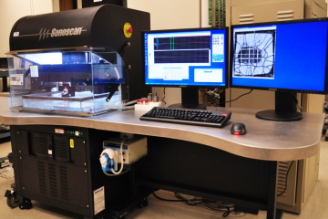Helping Electric-Drive Vehicle Power Electronics Keep Their Cool

NREL researchers used a C-Mode Scanning Acoustic Microscope, a non-destructive ultrasound
inspection tool, to evaluate thermal interfaces before and during cycling and aging
tests.
Photo by Douglas DeVoto, NREL
The electronics in hybrid and electric vehicles generate a lot of heat, so keeping those components cool is a critical factor in keeping these vehicles running efficiently and reliably. Unfortunately, the conventional adhesives and solders that connect these electronic devices to their heat sinks are generally either poor heat conductors, or they form cracks and defects when they cycle up and down in temperature.
That's why the Defense Advanced Research Projects Agency (DARPA) launched a project to explore the use of nanomaterials in these adhesives and solders, which are generally known as thermal interface materials (TIMs). Nanomaterials take advantage of the unusual behavior of materials at the nanoscale, or roughly a billionth of a meter.
DARPA contracted with General Electric Global Research Center (GE), Georgia Tech, Raytheon, and Teledyne to explore a variety of approaches to making better TIMs. GE explored the use of metal nanosprings, Georgia Tech investigated open-ended carbon nanotubes, Raytheon looked into layered metallic bonding materials, and Teledyne pursued a laminate of solder and flexible graphite films.
NREL's role was to test the resulting materials to see if they met DARPA's goal to increase the conductance of the TIM layers to one watt per square millimeter per degree Kelvin or more -- equivalent to reducing the resistance to one mm2-K/W or less.
"Conventional thermal interface materials can pose a significant bottleneck to heat removal from power electronics packages," said NREL's Sreekant Narumanchi. "Hence, high-performance thermal interface materials are a critical enabler to compact, high-performance, low-cost power electronics components for transportation and other applications."
Accurately measuring the resistance of nanoscale layers across a large area is difficult. NREL's approach was to first measure the steady-state resistance of TIM samples, followed by thermal cycling and thermal aging of the samples. The samples were tested for thermal resistance before and after the thermal aging.
The NREL testing found that all of the technology developers had improved the performance of TIMs substantially, but only GE was able to deliver a TIM with a resistance below the DARPA goal, at 0.7 mm2-K/W. And unlike its competitors, the GE samples performed consistently well under thermal cycling and thermal aging tests. The results are included in a technology review paper, published by the Journal of Electronic Packaging in October.

